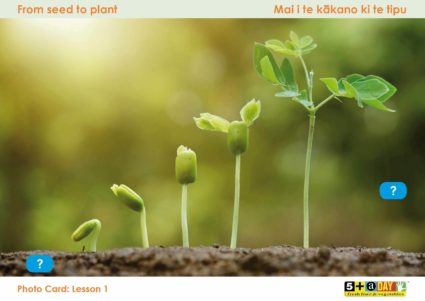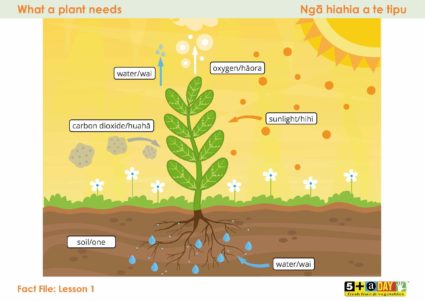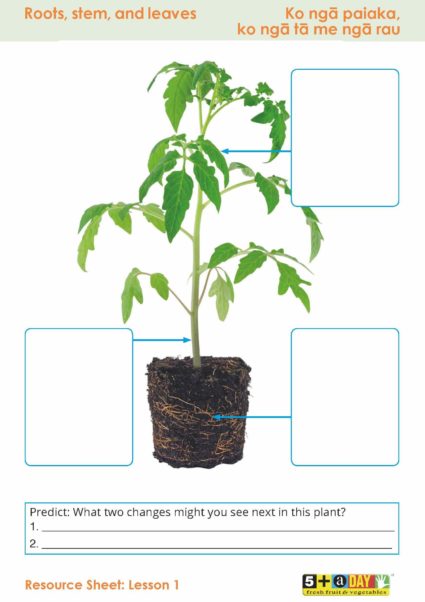Primary
Lesson 1: Growing Plants from Seeds
This is the first of two lessons in which students can discuss the process of germination and plant growth, leading to a practical long-term activity that will show them how plants grow from seeds to provide us with fresh vegetables/huawhenua hou.

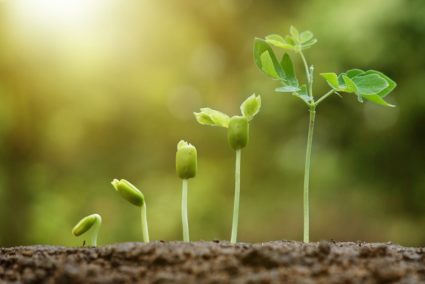
This lesson is featured in our printed resource; Book 1: Growing and Learning with 5+ A Day, Levels 1 & 2.
Order the print version here or download here to print yourself.
Learning Intentions
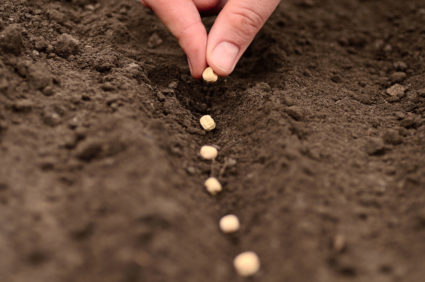
Students will:
- discuss how plants grow from seeds
- understand that growing plants have specific needs
- explore the germination process
- encounter and use Māori terms for scientific objects and processes.
Possible Achievement Objectives
Science: Levels 1 & 2
LIFE PROCESSES
Students will:
- recognise that all living things have certain requirements so they can stay alive.
ECOLOGY
Students will:
- recognise that living things are suited to their particular habitat.
INVESTIGATING IN SCIENCE
Students will:
- extend their experiences and personal explanations of the natural world through exploration, play, asking questions, and discussing simple models.
Preparation
What You Need
- Photo Card: From seed to plant/Mai i te kākano ki te tipu
- Fact File: What a plant needs/Ngā hiahia a te tipu
- eBook: Fredge Plants Some Seeds
- Resource Sheet: Roots, stem, and leaves/Ko ngā paiaka, ko ngā tā me ngā rau
- Sprouted mung bean seeds
- Sticky notes/pens
Additional Resources
- Our Gifted Garden, Junior Journal 49:
https://tinyurl.com/hf56zqg - Seeds, Junior Journal 50:
https://literacyonline.tki.org.... - Dig In, Junior Journal 52:
https://tinyurl.com/htfcfwj - Extraordinary Earthworms, Ready to Read
https://instructionalseries.tki.org.... - Growing Pumpkins, Ready to Read
https://instructionalseries.tki.org....
Key Vocabulary
These words are important to this lesson, and can be defined and explored in context as you discuss the topic with your students. A number of content words are provided in English and Māori. Introduce terms in both languages as appropriate.
germination/tinakutanga: to start growing from a seed or to sprout
photosynthesis/ahotakakame: the process by which plants use sunlight to create food from water and carbon dioxide in the air to help them grow
nutrients/taiora: minerals that plants absorb from the soil to help them grow and stay healthy
Learning Opportunity
The learning opportunity below is a suggestion.
You can adapt and adjust the content as needed to support your students as they carry out their inquiries.
Your role is to help your students generate rich questions about the topic of how plants grow from seeds, and to understand all the factors involved in doing this successfully.
As a part of this process, you can help to reinforce the message that eating fresh vegetables is an important part of making healthy lifestyle choices.
The Lesson
Photo Card: From seed to plant/Mai i te kākano ki te tipu
Begin the lesson by showing the students the Photo Card: From seed to plant/Mai i te kākano ki te tipu (click on the image to enlarge, download, and print).
- What does this photograph show you? (Explain that it is a “time-lapse” image.)
- Where is this happening? (in the ground/kei roto i te whenua)
Point to the blue spot on the left of the picture.
- What would the first photograph in the series show? (a seed)
- Where is the seed?/Kei whea te kākano? (under the soil/kei raro i te one)
- Why is the seed/plant changing? What changes can you see?
Point to the blue spot on the right of the picture.
- What would the next photograph in the series be?
eBook: Fredge Plants Some Seeds
At this point, you can stop and share the eBook, Fredge Plants Some Seeds (click on the cover of the eBook). There is audio for this story, which you can use if you wish, or students can take turns to read the text
The messages in this eBook reinforce the factual information about planting and growing seeds that has been discussed so far and which will be expanded on. For information on using 5+ A Day eBooks, click here.
There are two interactive activities that follow the eBook. They work on a computer, a tablet, or an IWB. They can be used during or at the end of the lesson or in choosing time to reinforce key information from the story. Students will get the most from these activities if you model them first. Try each activity as a group and explain the actions required and the aims of the activity.
For Activity 1, drag each item onto the garden in the correct order: soil, compost, seeds, water, and sun. For Activity 2, help keep Fredge’s seeds safe from the blackbirds. Each time a bird swoops down, drag the correct mini-scarecrow onto the bird to scare it off. Use the left-hand scarecrow for the left-hand birds, and the right-hand scarecrow for the right-hand birds.
Compare and Contrast
Now show the students the mung bean sprouts.
Give them each a few sprouts to look at closely, then show the Photo Card: From seed to plant again (click on the image to enlarge, download, and print).
Look at the photograph.
- Can you see anything that looks like your sprouts?
- What might happen if we put your sprouts into some soil and watered them?
- How could we watch a seed grow to a plant? (Plant the seeds and observe daily growth.)
- What would we need to make sure the seed started to grow, and kept on growing?
Ask the students to discuss the following questions:
- What things does a seed need to sprout?
- What does it need to keep growing into a plant?
Ask some of the students to share their ideas with the class.
Fact File: What a plant needs/Ngā hiahia a te tipu
Now show the students the Fact File: What a plant needs/Ngā hiahia a te tipu (click on the image to enlarge, download, and print).
Ask them to work in pairs and discuss the diagram.
Then ask for volunteers to talk about each label and what it means. Provide support with any definitions by describing them simply.
Use the Māori words for the elements involved in photosynthesis as appropriate.
- What are the arrows telling you?
- What would happen if there was no water in the soil?
Plants need carbon dioxide, water, and sunlight to grow and stay healthy.
Carbon dioxide is a gas that is in the air all around you. The air passes through tiny holes in the leaves. These holes are called stomata. Water enters the plant through the roots and flows up the stem on to the leaves.
Sunlight is absorbed by a green chemical in the leaves.
Photosynthesis happens in the leaves of plants. Leaves are made up of very small cells. In each cell there are tiny things called chloroplasts. Each chloroplast has a green chemical called chlorophyll in it. This gives leaves their green colour.
Here’s how photosynthesis works:
- The chlorophyll absorbs energy from sunlight.
- The energy is used to split water into two gases called hydrogen and oxygen.
- Oxygen comes out of the leaves into the atmosphere.
- The hydrogen and carbon dioxide from the air are used to make glucose or food for plants.
- Some of the glucose is used to help the plant grow. Some is stored so the plant can use it later.
Reflect on the Learning
This is the time to reflect on the learning outcomes for the lesson, and to signal the next lesson focus, where students will run their own inquiry. It is also a time for students to talk and share ideas that are still unclear.
In reflecting on this lesson, the discussion will focus on the processes of germination and photosynthesis. Review the vocabulary used in the lesson:
- water/wai
- soil/one
- carbon dioxide/huahā
- oxygen/hāora
- sunlight/hihi
- photosynthesis/ahotakakame.
To follow up, students can work in pairs or independently on the Resource Sheet: Roots, stem, and leaves/Ko ngā paiaka, ko ngā tā me ngā rau. You can click on the image and download the active PDF for them to complete (they can type directly into the spaces provided) or print the sheet for them to work on.
This resource sheet shows a tomato plant that has reached the leafing stage, but has yet to produce flowers or fruit. The students need to label the parts of the plant that are indicated and explain how they contribute to the healthy growth of the plant. Then they can answer the focusing question:
- What are the next two changes this plant will make?

